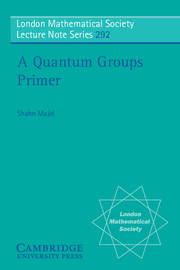Book contents
- Frontmatter
- Contents
- Preface
- 1 Coalgebras, bialgebras and Hopf algebras. Uq(b+)
- 2 Dual pairing. SLq(2). Actions
- 3 Coactions. Quantum plane A2q
- 4 Automorphism quantum groups
- 5 Quasitriangular structures
- 6 Roots of unity. uq(sl2)
- 7 q-Binomials
- 8 Quantum double. Dual-quasitriangular structures
- 9 Braided categories
- 10 (Co)module categories. Crossed modules
- 11 q-Hecke algebras
- 12 Rigid objects. Dual representations. Quantum dimension
- 13 Knot invariants
- 14 Hopf algebras in braided categories. Coaddition on A2q
- 15 Braided differentiation
- 16 Bosonisation. Inhomogeneous quantum groups
- 17 Double bosonisation. Diagrammatic construction of uq(sl2)
- 18 The braided group uq(n+). Construction of uq(g)
- 19 q-Serre relations
- 20 R-matrix methods
- 21 Group, algebra, Hopf algebra factorisations. Bicrossproducts
- 22 Lie bialgebras. Lie splittings. Iwasawa decomposition
- 23 Poisson geometry. Noncommutative bundles. q-Sphere
- 24 Connections. q-Monopole. Nonuniversal differentials
- Problems
- Bibliography
- Index
9 - Braided categories
Published online by Cambridge University Press: 18 January 2010
- Frontmatter
- Contents
- Preface
- 1 Coalgebras, bialgebras and Hopf algebras. Uq(b+)
- 2 Dual pairing. SLq(2). Actions
- 3 Coactions. Quantum plane A2q
- 4 Automorphism quantum groups
- 5 Quasitriangular structures
- 6 Roots of unity. uq(sl2)
- 7 q-Binomials
- 8 Quantum double. Dual-quasitriangular structures
- 9 Braided categories
- 10 (Co)module categories. Crossed modules
- 11 q-Hecke algebras
- 12 Rigid objects. Dual representations. Quantum dimension
- 13 Knot invariants
- 14 Hopf algebras in braided categories. Coaddition on A2q
- 15 Braided differentiation
- 16 Bosonisation. Inhomogeneous quantum groups
- 17 Double bosonisation. Diagrammatic construction of uq(sl2)
- 18 The braided group uq(n+). Construction of uq(g)
- 19 q-Serre relations
- 20 R-matrix methods
- 21 Group, algebra, Hopf algebra factorisations. Bicrossproducts
- 22 Lie bialgebras. Lie splittings. Iwasawa decomposition
- 23 Poisson geometry. Noncommutative bundles. q-Sphere
- 24 Connections. q-Monopole. Nonuniversal differentials
- Problems
- Bibliography
- Index
Summary
In this lecture we start a block of the course in which we study the representation theory of quantum groups and its applications. We will see that they are intimately connected with braids and knots.
We start with some abstract definitions of monoidal and braided categories. A category C for our purposes is just
1. A collection of objects V, W, Z, U, ….
2. A specification of a set Mor(V, W) of morphisms for each V, W.
The sets Mor(V, W), Mor(Z, U) are disjoint unless V = Z and W = U.
3. A composition operation ∘ : Mor(W, Z) × Mor(V, W) → Mor(V, Z) with properties analogous to the composition of maps (such as associativity of ∘ where defined).
4. Every set Mor(V, V) should contain an identity element idV such that φ ∘ id = φ, id ∘ φ = φ for any morphism for which ∘ is defined.
A more formal treatment is in Mac Lane's book for anyone interested. In our case all objects will be concrete sets with structure (actually vector spaces equipped with linear maps of various kinds), all morphisms will be linear maps obeying various restrictions, and all categories will be equivalent to essentially small ones (i.e. we will not digress on topos theory and other subtleties). We are primarily going to use the language of category theory to keep our thinking clear. In particular, we indicate objects as V ∈ C by an abuse of set theory notations.
- Type
- Chapter
- Information
- A Quantum Groups Primer , pp. 52 - 57Publisher: Cambridge University PressPrint publication year: 2002



